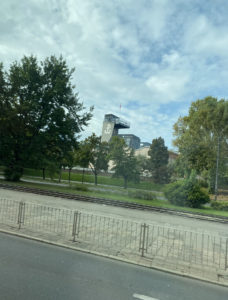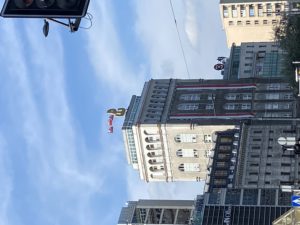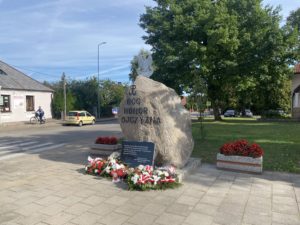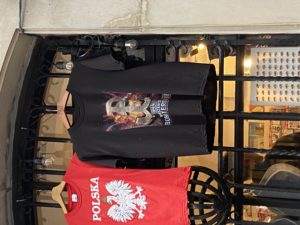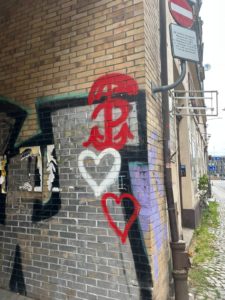The Kotwica
By Ian Eisenbrand
In Polish, Kotwica means anchor. It is also the term used to describe an enduring, highly contested symbol of Polish resistance dating back to World War II. The Kotwica was conceived in Warsaw in 1942 as an emblem for the Home Army, the leading underground resistance movement in Poland during German occupation. During WWII, the broader Polish resistance movement adopted the sign, which is formed by connecting the letters P and W. In August 1944, the symbol, painted on walls in German-occupied Warsaw, signaled the launch of the largest uprising in Nazi-occupied Europe. The uprising ended in failure, with 150,000 civilians killed in the fight and the majority of Warsaw’s city center leveled to the ground. Since the end of the war, the symbol’s relevance persists and continues to evolve through its reappropriation in several formative moments of contemporary resistance within Poland.
In order to understand the Kotwica’s present significance, it’s first necessary to understand the symbol’s longevity as the product of the German and Soviet occupations. Alena Aniskiewicz, a professor of Slavic Literature and Languages, explains that the sign initially stood for Pomścimy Wawer, or We Shall Avenge Wawer – a reference to the Wawer Massacre of 1939, “one of the first massacres of Poles in occupied Poland, […] its memory [fueling] the opposition in Warsaw”, (Aniskiewicz). In the summer of 1944, though, the Kotwica found its most pivotal role as the emblem of the Warsaw Uprising, one of the most significant movements of Polish resistance to German occupation. In the two years following its invention, the symbol’s meaning had shifted with the P and W recast to stand for Polska Walcząca, or Fighting Poland. The profound outcry of Polish voices in the Warsaw Uprising gave way to the Kotwica’s rapid proliferation through occupied Polish territories, representing a desire for a return to Polish independence and the existence of an underground movement ready to fight. More broadly, the symbol became the collective call for Poles to join the resistance and fight back against occupying forces.
Tragically, the end of World War II saw the symbol stifled as the Soviet Union sunk its grip over Poland in the power vacuum created by the defeat of Germany. The new communist regime in Poland, instated through Soviet intervention, quickly banned the Kotwica. This prohibition successfully suppressed broader access to the memories of the wartime resistance movement. However, as opposition to the regime gathered, the Kotwica reemerged once again. In the city of Gdansk, the Kotwica was used to silently mark the graves of men slain in the December 1970 massacre of striking shipyard workers by Polish soldiers. In an article published by Artforum, Lawrence Weschler details that “[at] the Gdansk cemetery, where actual mention of the circumstances of the strikers’ deaths was forbidden, mourners would mark the grave of a slain worker by hanging a small anchor from the feet of the headstone’s traditional crucifix”, (Weschler). A decade later, the massacre was finally recognized by the government in August 1980 with the allowance of a memorial’s construction at the shipyard. The shipyard workers constructed three steel crosses standing 140 feet tall, each marked by a cresting anchor, a symbol of the martyrs lost in the massacre (Weschler).
This early use of the Kotwica in the anti-communist resistance movement also inspired the points of action taken around the establishment of the Solidarity trade union. The 1980s saw the Solidarity union transform into the largest social movement in modern Polish history, reaching its ultimate objective in 1989 with the establishment of a new democratically elected government independent of the Soviet Union and a free market economy. The Kotwica can be understood in its role in the Solidarity movement as a provocation and reminder of an unrelenting Polish civic duty of resistance, even as (or perhaps especially when) it makes martyrs.
The Kotwica can still be seen across Poland, often implemented as the seal of a resilient Polish sovereignty. In Warsaw, the symbol is embraced as the insignia of Poland’s capital, marking significant government buildings in the city, such as the Supreme Court of Poland. As the birthplace of the Kotwica and nucleus of historical Polish resistance, Warsaw also honors the Kotwica as a graphic motif for both the pride and grief that remain in the spirit of Poland from the struggle it faced at the hand of its former occupiers. Some organizations that own buildings in downtown Warsaw allow the Kotwica to crest over city’s skyline, recognizing the scars and strength to be found in Poland’s past. The Warsaw Uprising Museum, a museum dedicated to the uprising, has the symbol painted on its observation tower. The Warsaw Ghetto Museum, a new installation in the city that will be concentrating on the historical Jewish ghetto that also had a deeply significant moment of resistance in Warsaw in 1943, embraces the Kotwica as a shared symbol of opposition. Though the museum is still under construction, its organizers perched a massive Kotwica on top of their office building. A few hours northeast of Warsaw, the quiet town of Sejny memorialized its lost soldiers in the fight for Polish independence with the Kotwica, inscribing a boulder along with what can be translated to, “… We want to follow in your footsteps”.
The Kotwica’s employment by the state and these educational organizations, while honorable in its messaging, does not reflect a comprehensive examination of the Kotwica’s meaning to the Polish people. It presents a ‘Fighting Poland’ that is clean, conclusive, and institutional, although the return of the Kotwica in the Solidarity Movement gave way to an understanding of the symbol that is still unfolding into the twenty-first century. Since the return of Polish democracy in 1989, the Kotwica has been reappropriated by several social action movements in Poland, with the adoption of the symbol stretching across polar ends of the political spectrum. In an article published in 2019, ‘Never Again’ Association, a Polish anti-racist organization, documented the appropriation of the Kotwica by far-right nationalist groups, specifically in association with violent hate crimes in recent years. Ironically, the article comments that while the symbol was originally created for the battle against fascism, the nationalist groups who adopted the Kotwica, “espouse ideologies close to fascism” (“Never Again” Association). In their application of the Kotwica, these nationalist groups conflate their understanding of the symbol with a level of solidarity with a ‘Fighting Poland.’ Polish nationalism is rooted fundamentally in fears of encroachment, with this contemporary anxiety centering on the sacrifice of Polish identity to the economic dominance and cultural infiltration of Western ideology. Populist groups, such as the Law and Justice (PiS) party, rely on these fears and remain in power due to the entrenched nature of these attitudes in Poland. Individual and systemic retaliation to perceived Western intrusion frequently targets immigrants, women, members of the LGBTQ+ community, and other minority groups. The adoption of the Kotwica in this bigoted cruelty represents an intractable psychological conflict among Poles in a collective trauma dealt by a battering, historical precedent of abuse and neglect.
On the other hand, the Kotwica was also used in 2016 in the Black Protests, a large-scale movement organized by Polish women opposing escalating federal restrictions on abortion; many protesters modified the arms of the Kotwica’s anchor to resemble breasts (Wądołowska). Telewizja Republika, a Polish television station, reported in 2017 that lawsuits were filed against protestors who altered the Kotwica during these protests before the District Court of Kielce. The article argues the alteration was insulting to the legally protected meaning of the Kotwica as a symbol of the struggle of the Polish nation during World War II (Ordo Iuris). No such legal action has been taken against far-right nationalist groups in their usage of the symbol. Once again, though, the Kotwica and its movement prevailed over this legal suppression. Surrounded by inequity, journalist Agnieszka Wądołowska reported in 2020 that the Kotwica was still widely adopted by those protesting further federal restrictions placed on abortion that year (Wądołowska), claiming that many believe these protests were the largest in Poland since the Solidarity movement. These protests claim the Kotwica as their own, opposing the Kotwica’s appropriation by the same ideologies that look to suffocate their movement, paradoxically sharing the defiance to a perceived intrusion of the inborn rights of citizenship.
One principal change between the acts of resistance taken in these protests compared to their twentieth century predecessors and Polish nationalist groups is that the Polish nation has recast itself as not only the victim of these injustices, but also as a central perpetrator in contemporary issues. The abuse has transferred from the hands of uncontrollable external interference into something organic, intergenerational trauma cultivated through structural neglect within the free state of Poland. The enduring use of the Kotwica indicates the resistance to these abuses are still fundamental to the perspective of the Polish citizen. As the Kotwica’s meaning evolved in the past century, especially in the last decade, the symbol remains grounded in a fundamental, ceaseless hunger for recognition by the systems of power. While it could be said that the spirit of the Warsaw Uprising is easily misplaced, or even bastardized in some of the nationalist appropriations of the Kotwica, it will always be unfair to place the blame solely on the citizens deemed a plague in their own land, not unlike those who once lived in the charred ruins of Warsaw. These contemporary groups both share an exhaustion with the label of disease imparted on them by the very same government that promised something more than disregard in 1989. Past the corrosive direction taken by some of these groups, the presence of needs that remain unrecognized prevail as the Kotwica’s cradle. In that, empathy is warranted, even in incompatible moral and political stances. The historical precedents of Polish citizenship set in the Warsaw Uprising are by no means remote. While it could be argued the use of the Kotwica in contemporary movements is defined by convolution, the open wounds it exposes still provide the opportunity to act towards healing.
Works Cited
- “Never Again” Association. Brown Book. “Never Again” Association, 2019. https://www.nigdy
wiecej.org/docstation/com_docstation/172/brown_book_2019.pdf. - Ordo Iuris. Ordo Iuris broni znaku Polski Walczącej znieważonego podczas Czarnego Marszu
w Kielcach. Telewizja Republika, 2017. https://tvrepublika.pl/ordo-iuris-broni-znaku- polski-walczacej-zniewazonego-podczas-czarnego-marszu-w-kielcach,48107.html. - Wądołowska, Agnieszka. The symbols of Poland’s abortion protests explained. Notes From
Poland, 2020. https://notesfrompoland.com/2020/10/30/the-symbols-of-polands-a
bortion-protests-explained/. - Weschler, Lawrence. Solidarność. Artforum. https://www.artforum.com/features/solidarno-
208413/.


